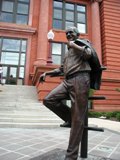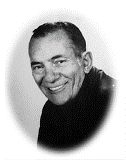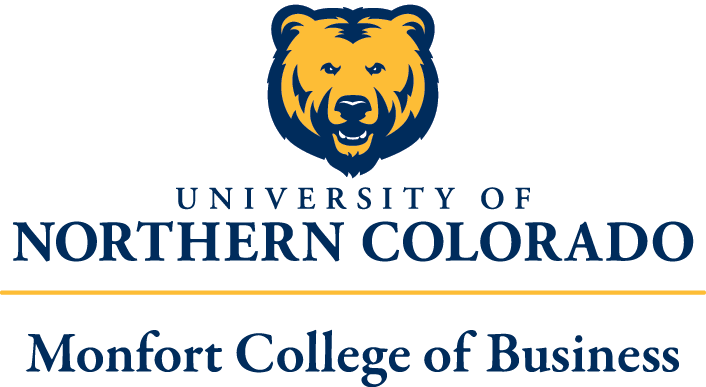 A friend of Ken Monfort's once bought a new pair of alligator shoes and showed them
off to the cattleman. Monfort, who dislikes neckties and wears a turtleneck under
his dinner jacket, wasn't interested in the reptilian footwear. "Money is wasted on
you, Monfort," the friend said. But years later, when the friend called with congratulations
on the new name of the University of Northern Colorado's Business School, Monfort
told him, "I could do this because I didn't buy alligator shoes."The anecdote is emblematic
of the Greeley beef baron, political figure and philanthropist. Ken Monfort became
a rancher by an accident of wartime heroism. His older brother, Richard, who served
as a navigator in World War II, was assumed to be the rancher of his generation and
eventual successor to their father, Warren Monfort. But the family received the awful
news on February 14, 1944, that Lt. Richard Monfort was missing in action over Germany
and presumed dead. The task of running the family business fell to Ken.
A friend of Ken Monfort's once bought a new pair of alligator shoes and showed them
off to the cattleman. Monfort, who dislikes neckties and wears a turtleneck under
his dinner jacket, wasn't interested in the reptilian footwear. "Money is wasted on
you, Monfort," the friend said. But years later, when the friend called with congratulations
on the new name of the University of Northern Colorado's Business School, Monfort
told him, "I could do this because I didn't buy alligator shoes."The anecdote is emblematic
of the Greeley beef baron, political figure and philanthropist. Ken Monfort became
a rancher by an accident of wartime heroism. His older brother, Richard, who served
as a navigator in World War II, was assumed to be the rancher of his generation and
eventual successor to their father, Warren Monfort. But the family received the awful
news on February 14, 1944, that Lt. Richard Monfort was missing in action over Germany
and presumed dead. The task of running the family business fell to Ken.
Certainly he was no novice. The front page of a 1941 Denver Post carried a photo of 12-year-old Ken and the Grand Champion Steer he had just sold for $1,055. It was a ten-fold profit over the $105.50 he paid for the calf a year earlier. No small part of Ken Monfort's later success lay, his competitors were to learn, in his head for figures.
The enterprise Ken joined after attending Colorado State University had been much changed by his far-sighted, innovative father. The agricultural Great Depression and its plummeting farm prices had begun even before the crash of 1929. By 1928, Warren and Edith Monfort, college graduates who had met while teaching school in Sterling, were considering abandoning agriculture and returning to education.
With beef prices disastrously low, Warren realized that his only hope was to strengthen and expand his market. In the 1920s, cattle were still rounded up, sold and slaughtered in the fall. Fresh beef in the urban market was one of many seasonal delicacies. So the elder Monfort began feeding cattle year-round, which let him sell at advantageous prices all year. The technique revitalized the beef industry.
The feedlot was the basis of the Monfort enterprise, but more innovations would follow. In 1970, Ken Monfort succeeded his father as CEO and turned the business into a Fortune 500 company. Part of the success came from Ken's foresight. As a Monfort executive in the 1950s, he saw potential for his industry in the new Interstate highway grid. He relocated meat packing from the city back to rural areas, closer to feedlots. At the same time, he began to shape, or fabricate, carcasses of slaughtered animals to order.
By the 1950s, supermarkets and consumers were end users of Monfort meats. At great expense, stores employed butchers to separate the carcass into usable meats, a laborious process that wasted some of the carcass. Under Ken's leadership, the company began to do this essential butchering in house, cutting the carcass into what was known as primal cuts before shipping to stores. Beef fabrication, once more, revolutionized the industry and recast the relationship between meat packers and retailers.
 In these busy years, Ken Monfort also found time for public service. He was elected
to the Colorado General Assembly. In 1968, he ran against former Colorado Governor
Steve McNichols for the Democratic Party's U.S. Senate nomination. Monfort opposed
U.S. military involvement in Southeast Asia, which his rival supported. McNichols
won the primary battle, but lost the general election war to Republican Peter Dominick.
But is was Monfort's campaign that opened the Democratic Party in Colorado to others
critical of the war. His candidacy is still recalled as a watershed in recent Colorado
political history.
In these busy years, Ken Monfort also found time for public service. He was elected
to the Colorado General Assembly. In 1968, he ran against former Colorado Governor
Steve McNichols for the Democratic Party's U.S. Senate nomination. Monfort opposed
U.S. military involvement in Southeast Asia, which his rival supported. McNichols
won the primary battle, but lost the general election war to Republican Peter Dominick.
But is was Monfort's campaign that opened the Democratic Party in Colorado to others
critical of the war. His candidacy is still recalled as a watershed in recent Colorado
political history.
Back on the business front, Monfort of Colorado, Inc. in 1970 was named Employer of the Year by former Colorado Governor John Love, who cited the company's distinguished record of hiring and retaining the disadvantaged. The company emerged healthy after narrowly surviving the rampant inflation and labor troubles of the Carter years. In 1988, in one of the most significant deals ever seen in the food industry, Monfort of Colorado, Inc. was sold to ConAgra Red Meat Companies.
Ken Monfort continued as president of the company during the transition. But it was soon time for him to retire. The free time allowed him to fulfill a lifetime ambition to write by commenting on public affairs in his "Random Thoughts" columns that appeared in the Greeley Tribune. He also turned his considerable talents to philanthropy, which would help remake northern Colorado. In addition to UNC's Kenneth W. Monfort College of Business, the Monfort family has been key in supporting the Union Colony Civic Center, the Monfort Family Birth Center at North Colorado Medical Center, and the Monfort Children's Clinic. Much of the cost of Greeley Veterans' Park was provided by the Monforts, who wished to recall the sacrifice of Lt. Richard Monfort.
Monfort's contributions to Colorado and the west were noted in 1991 when he received the prestigious "Citizen of the West award from the National Western Stock Show, which honored him as "a pioneer in the livestock industry and community leader in Colorado and the Rocky Mountain West". The career of the boy who had sold his prize-winning Hereford for a dollar a pound in 1941 at the Stock Show had come full circle.
 Ken Monfort has always been true to his rural roots. He earned a reputation for personal
integrity and business acumen that is matched only by his commitment to the community
where he and his family nurtured and sustained one of the most successful businesses
in the west. His name on UNC's College of Business will not only serve as an inspiration
to generations of students, it will continue a tradition of excellence in northern
Colorado.
Ken Monfort has always been true to his rural roots. He earned a reputation for personal
integrity and business acumen that is matched only by his commitment to the community
where he and his family nurtured and sustained one of the most successful businesses
in the west. His name on UNC's College of Business will not only serve as an inspiration
to generations of students, it will continue a tradition of excellence in northern
Colorado.


